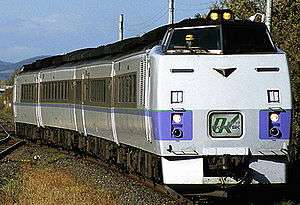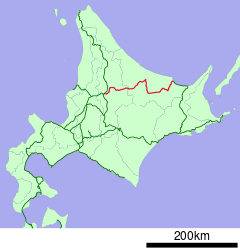Sekihoku Main Line
| Sekihoku Main Line | |||
|---|---|---|---|
|
| |||
| Overview | |||
| Native name | 石北本線 | ||
| Type | Heavy rail | ||
| Status | In operation | ||
| Locale | Hokkaido | ||
| Termini |
Shin-Asahikawa Abashiri | ||
| Stations | 40 | ||
| Operation | |||
| Owner | JR Hokkaido | ||
| Operator(s) | JR Hokkaido, JR Freight | ||
| Rolling stock | KiHa 50, 183 Series, KiHa 54 | ||
| Technical | |||
| Line length | 257.8 km (160.2 mi) | ||
| Track gauge | 1,067 mm (3 ft 6 in) | ||
| Electrification | None | ||
| Operating speed | 110 km/h (70 mph) | ||
| |||
| Sekihoku Main Line | ||||||||||||||||||||||||||||||||||||||||||||||||||||||||||||||||||||||||||||||||||||||||||||||||||||||||||||||||||||||||||||||||||||||||||||||||||||||||||||||||||||||||||||||||||||||||||||||||||||||||||||||||||||||||||||||||||||||||||||||||||||||||||||||||||||||||||||||||||||||||||||||||||||||||||||||||||||||||||||||||||||||||||||||||||||||||||||||||||||||||||||||||
|---|---|---|---|---|---|---|---|---|---|---|---|---|---|---|---|---|---|---|---|---|---|---|---|---|---|---|---|---|---|---|---|---|---|---|---|---|---|---|---|---|---|---|---|---|---|---|---|---|---|---|---|---|---|---|---|---|---|---|---|---|---|---|---|---|---|---|---|---|---|---|---|---|---|---|---|---|---|---|---|---|---|---|---|---|---|---|---|---|---|---|---|---|---|---|---|---|---|---|---|---|---|---|---|---|---|---|---|---|---|---|---|---|---|---|---|---|---|---|---|---|---|---|---|---|---|---|---|---|---|---|---|---|---|---|---|---|---|---|---|---|---|---|---|---|---|---|---|---|---|---|---|---|---|---|---|---|---|---|---|---|---|---|---|---|---|---|---|---|---|---|---|---|---|---|---|---|---|---|---|---|---|---|---|---|---|---|---|---|---|---|---|---|---|---|---|---|---|---|---|---|---|---|---|---|---|---|---|---|---|---|---|---|---|---|---|---|---|---|---|---|---|---|---|---|---|---|---|---|---|---|---|---|---|---|---|---|---|---|---|---|---|---|---|---|---|---|---|---|---|---|---|---|---|---|---|---|---|---|---|---|---|---|---|---|---|---|---|---|---|---|---|---|---|---|---|---|---|---|---|---|---|---|---|---|---|---|---|---|---|---|---|---|---|---|---|---|---|---|---|---|---|---|---|---|---|---|---|---|---|---|---|---|---|---|---|---|---|---|---|---|---|---|---|---|---|---|---|---|---|---|---|---|---|---|---|---|---|---|---|---|---|---|---|---|---|---|---|---|---|---|---|---|---|---|---|---|---|---|---|---|---|---|---|---|---|---|---|---|
Legend
| ||||||||||||||||||||||||||||||||||||||||||||||||||||||||||||||||||||||||||||||||||||||||||||||||||||||||||||||||||||||||||||||||||||||||||||||||||||||||||||||||||||||||||||||||||||||||||||||||||||||||||||||||||||||||||||||||||||||||||||||||||||||||||||||||||||||||||||||||||||||||||||||||||||||||||||||||||||||||||||||||||||||||||||||||||||||||||||||||||||||||||||||||
Sekihoku Main Line (石北本線 Sekihoku-honsen) is a Japanese railway line in Hokkaido, Japan, operated by Hokkaido Railway Company (JR Hokkaido) between Shin-Asahikawa in Asahikawa and Abashiri Station in Abashiri. The name comes from Ishikari Province (石狩国) and Kitami Province (北見国), names of ancient provinces along the line.[1]
On 19 November 2016, JR Hokkaido's President announced plans to rationalise the network by up to 1,237 km, or ~50% of the current network,[2] including the proposed conversion to Third Sector operation of the Sekihoku Main Line, but if local governments are not agreeable, the line will face closure.
Basic data
- Operators, distances
- Hokkaido Railway Company (Services and tracks)
- Whole line, from Shin-Asahikawa to Abashiri: 234.0 km
- Japan Freight Railway Company (Services)
- From Shin-Asahikawa to Kitami: 181.0 km
- Hokkaido Railway Company (Services and tracks)
- Signal boxes: 4
- Track: single
- Block system: Automatic
Services
The Okhotsk limited express train, named after the Sea of Okhotsk, runs from Sapporo to Abashiri four times a day in summer, six times a day in winter.[3] The limited rapid train Kitami operates between Asahikawa and Kitami, with one return service daily.
Local services along the line are roughly divided into three segments. In the segment between Asahikawa and Kamikawa, the line functions as a commuter rail of Asahikawa City. There is one local train service per one to two hours. The segment between Kamikawa and Engaru is a sparsely populated area. Between Kakikawa and Shirataki, a local train runs one lap per day. For the segment between Engaru and Abashiri, there is one local train service per one to two hours.
Stations
- LE: Limited Express
- R: Rapid
- All trains stop at stations marked +. Some trains stop at those marked *. No trains (other than local) stop at those marked -.
| Station | Distance (km) |
LE | R | Transfers | Location | ||
|---|---|---|---|---|---|---|---|
| Sōya Main Line | |||||||
| A28 | Asahikawa | 旭川 | -3.7 | + | + | Asahikawa | |
| A29 | Asahikawa-Yojō | 旭川四条 | -1.9 | - | - | ||
| A30 | Shin-Asahikawa | 新旭川 | 0.0 | - | - |
■ Sekihoku Main Line | |
| Sekihoku Main Line | |||||||
| A31 | Minami-Nagayama | 南永山 | 2.5 | - | - | Asahikawa | |
| A32 | Higashi-Asahikawa | 東旭川 | 5.2 | - | - | ||
| A33 | Kita-Hinode | 北日ノ出 | 7.3 | - | - | ||
| A34 | Sakuraoka | 桜岡 | 10.2 | - | - | ||
| A35 | Tōma | 当麻 | 13.9 | - | + | Tōma, Kamikawa | |
| A36 | Shōgunzan | 将軍山 | 17.4 | - | - | ||
| A37 | Ikaushi | 伊香牛 | 19.5 | - | - | ||
| A38 | Aibetsu | 愛別 | 25.9 | - | - | Aibetsu, Kamikawa | |
| A39 | Naka-Aibetsu | 中愛別 | 32.0 | - | - | ||
| A40 | Aizan | 愛山 | 36.0 | - | - | ||
| A41 | Antaroma | 安足間 | 38.0 | - | - | ||
| A42 | Tōun | 東雲 | 40.4 | - | - | Kamikawa, Kamikawa | |
| A43 | Kamikawa | 上川 | 44.9 | + | + | ||
| A44 | Kami-Shirataki | 上白滝 | 78.9 | closed | Engaru, Monbetsu | ||
| A45 | Shirataki | 白滝 | 82.2 | * | + | ||
| A46 | Kyū-Shirataki | 旧白滝 | 88.3 | closed | |||
| A47 | Shimo-Shirataki | 下白滝 | 92.7 | closed | |||
| A48 | Maruseppu | 丸瀬布 | 101.9 | * | + | ||
| A49 | Setose | 瀬戸瀬 | 109.7 | - | - | ||
| A50 | Engaru | 遠軽 | 120.8 | + | + | ||
| A51 | Yasukuni | 安国 | 128.8 | - | + | ||
| A52 | Ikuno | 生野 | 132.7 | - | - | ||
| A53 | Ikutahara | 生田原 | 137.7 | + | + | ||
| A54 | Kanehana | 金華 | 152.7 | closed | |||
| A55 | Nishi-Rubeshibe | 西留辺蘂 | 156.2 | - | - | ||
| A56 | Rubeshibe | 留辺蘂 | 158.2 | + | + | ||
| A57 | Ainonai | 相内 | 169.1 | - | + | ||
| A58 | Higashi-Ainonai | 東相内 | 173.7 | - | + | ||
| A59 | Nishi-Kitami | 西北見 | 176.3 | - | + | ||
| A60 | Kitami | 北見 | 181.0 | + | + | ||
| A61 | Hakuyō | 柏陽 | 183.7 | - | |||
| A62 | Itoshino | 愛し野 | 185.9 | - | |||
| A63 | Tanno | 端野 | 187.3 | - | |||
| A64 | Hiushinai | 緋牛内 | 194.6 | - | |||
| A65 | Bihoro | 美幌 | 206.1 | + | Bihoro, Abashiri | ||
| A66 | Nishi-Memambetsu | 西女満別 | 213.1 | - | Ōzora, Abashiri | ||
| A67 | Memambetsu | 女満別 | 218.1 | + | |||
| A68 | Yobito | 呼人 | 225.9 | - | Abashiri | ||
| A69 | Abashiri | 網走 | 234.0 | + | |||
History
The principal route between Sapporo and Okhotsk Subprefecture has changed several times. Originally, the route was the Hakodate Main Line to Asahikawa, then the southbound Nemuro Main Line and then the northbound line from Ikeda, via the Abashiri Main Line (網走本線 Abashiri-honsen) to Kitami. The route shortened by 53.5 km when the section between Takikawa and Furano on the Nemuro Main Line opened in 1913.
Another route, northbound from Asahikawa to Nayoro, then southeast to Kitami was completed as the Nayoro Main Line (名寄本線 Nayoro-honsen) and Yūbetsu Line (湧別線 Yūbetsu-sen) in 1921.
A third route was a shortcut between Asahikawa and Engaru, straight through the Kitami Pass. The Sekihoku Line (石北線 Sekihoku-sen), completed in 1932, finally completed the main route still used today.
The current Sekihoku Main Line consists of the remnants of these three lines. The section between Shin-Asahikawa and Engaru is from the Sekihoku Line, the section between Engaru and Kitami from the Yūbetsu Line, and the section between Kitami and Abashiri from the Abashiri Main Line.
The first of the abovementioned sections to open was from Abashiri to Kitami in 1912. The Kitami to Engaru line was opened between 1912 and 1915 as a 762 mm (2 ft 6 in) gauge line, but was converted to 1,067 mm (3 ft 6 in) gauge in 1916.
The Asahikawa to Kamikawa section opened between 1922 and 1923, and the Engaru to Shiritaki section between 1927 and 1929. The final section, including the Ishikita tunnel, opened in 1932.
In July 2015, JR Hokkaido announced that it would be closing four stations line (Shimo-Shirataki Station, Kyu-Shirataki Station, Kami-Shirataki Station, and Kanehana Station) in March 2016, due to low passenger usage.[4]
See also
References
This article incorporates material from the corresponding article in the Japanese Wikipedia.
- ↑ JTB Timetable, February 2011 issue
- ↑ http://www.japantimes.co.jp/news/2016/11/19/business/jr-hokkaido-says-cant-maintain-half-railways/#.WDjkB9J96Ul
- ↑ http://www.jrasahi.co.jp/contents/facilities/facil_top.html
- ↑ 上白滝・旧白滝・下白滝の3駅も廃止 JR石北線、来年3月に [3 JR Sekihoku Line stations Kami-Shirataki, Kyu-Shirataki, and Shimo-Shirataki to close next March]. Doshin (in Japanese). Japan: The Hokkaido Shimbun Press. 22 July 2015. Archived from the original on 22 July 2015. Retrieved 12 January 2016.
External links
- JR Hokkaido official website (Japanese)
- JR Hokkaido official website (English)

